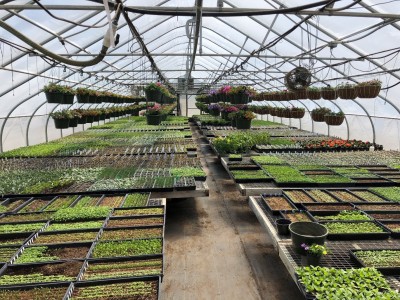Growers are Producing Great Transplants Despite Tough Weather Conditions
Crystal Stewart-Courtens, Extension Vegetable Specialist
Eastern New York Commercial Horticulture
The cold, cloudy weather which has defined this spring so far hasn't prevented growers throughout the region from producing quality transplants. Here are some of the key points which are keeping plants healthy and vigorous:
1) Start plants off right: a well-built germination chamber will effectively regulate temperature and relative humidity using minimal amounts of energy. You can find a couple of easy to build designs for chambers here. Germination chambers should only be used to "pop" seeds—as soon as you see the first seedlings emerge, remove plants to the greenhouse so they don't stretch.
2) Water with care: Cold is ok, cloudy is ok, but cold and cloudy causes real water management challenges. When growers are using supplemental heat to keep temperatures in an acceptable range it can be tough to make the decision to vent excess humidity, so often walking into the greenhouse during those conditions is like walking into the rainforest. High humidity and low light means almost no transpiration by the plants, so soil that is wet stays wet. The best solution to this problem is prevention—if heading into a period of cold, wet days, minimize watering. And don't be afraid to use gable end vents or ridge vents if it is too wet in the greenhouse!
3) Fertilize equally carefully: There are a few challenges with fertilizing during cool, cloudy weather. One is that if plants are not taking up water, they aren't taking up fertilizer, either. This might lead to the impulse to fertilize more, which can lead to excess salt buildup and root burning. Another issue is that when temperatures are below 60 degrees F, N fertilizers can convert to ammonium which can be toxic to plants at elevated levels. Successful management of this issue involves scaling back the nitrogen fertility during periods of cool, wet weather, and managing watering to prevent plants from staying waterlogged. Media with optimal moisture levels will have more nitrifying bacteria, which convert ammonium to useable forms. A full factsheet on managing ammonium can be found here.
4) Practice good sanitation: A certain amount of disease is almost inevitable during the growing conditions we've been facing this spring. Scouting the greenhouse regularly and carefully removing flowers with botrytis, watching for crown rots, and adjusting spacing to maximize airflow and light infiltration make it possible to keep plants going through tough times.

This article is from the April 26, 2018 edition of ENYCHP Vegetable News. To read the full newsletter, CLICK HERE.

Upcoming Events
Ag Labor Road Show IX
December 1, 2025 : Save the Date! - Ag Labor Roadshow Webinar 1
In addition to the in-person Ag Labor Roadshow program in our region on December 9, two webinars are scheduled for December 1 and December 22. Each webinar will focus on different program content that is different from the in-person sessions. These webinars are an added benefit to program registration.
December 9, 2025 : Save the Date - Ag Labor Road Show In-Person Event (Greenwich, NY)
Greenwich, NY
The Roadshow delivers essential updates on labor law, regulations, and workforce best practices—tailored for farm owners, managers, and ag service providers. Sessions also focus on practical strategies to boost communication, strengthen retention, and build a positive workplace culture.
The in-person session for Eastern NY is December 9 - Elks Lodge, Greenwich, NY - full day in person session
Additional in-person sessions are:
December 10 - Hilton Garden Inn, Watertown, NY, December 17 - Cornell AgriTech, Geneva, NY, December 18 - Genesee Community College, Batavia, NY
December 22, 2025 : Save the Date! - Ag Labor Roadshow Webinar 2
In addition to the in-person Ag Labor Roadshow program in our region on December 9, two webinars are scheduled for December 1 and December 22. Each webinar will focus on different program content that is different from the in-person sessions. These webinars are an added benefit to program registration.
How to Obtain a Pesticide Applicator License
December 17, 2025
Thinking about becoming a certified pesticide applicator in New York, but aren't sure where to start? Join DEC representative Kenneth Klubek for a discussion on who needs to become a certified pesticide applicator, certification types, examination procedures, and recertification. Participants will have ample opportunity to ask questions during the program.
2026 Winter Cut Flower Webinar Series
January 6, 2026 : Session 1: Cut Flower Cost Calculator Updates and Woody Cuts
Session 1: Cut Flower Cost Calculator Updates and Woody Cuts
January 13, 2026 : Session 2: Perennials and Industry Trends
Session 2: Perennials and Industry Trends
January 20, 2026 : Session 3: Anaerobic Soil Disinfestation and Biochar
Session 3: Anaerobic Soil Disinfestation and Biochar
January 27, 2026 : Session 4: Beneficial Insects and Propagation Techniques
Session 4: Beneficial Insects and Propagation Techniques
February 3, 2026 : Session 5: Fungal and Insect Pests and Market Trends
Session 5: Fungal and Insect Pests and Market Trends












































